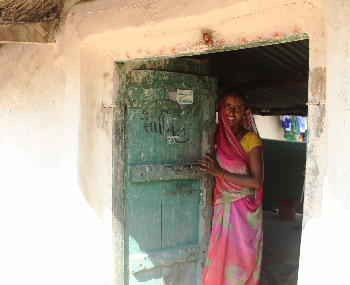Bundelkhand: No Water For Swacch Bharat Toilets
Swachh Bharat Mission (Gramin) reports that Uttar Pradesh is 83.7 percent ODF while 60.75 percent of Madhya Pradesh was declared ODF as on July 25, 2018. Which means, approximately 17 percent of UP and 40 percent of MP has yet to become ODF. The clock is ticking because the deadline of 2 October 2019 is coming up.
 Jigyasa Mishra 13 Oct 2018 2:13 PM GMT
Jigyasa Mishra 13 Oct 2018 2:13 PM GMT

Chitrakoot: She measures water out of a steel pot to pour it into the potato curry. "This much should be enough. Salt would ensure the further cooking," Kamla Devi said as she increased the flame of her stove. Then she kept the water left in the pot aside for drinking, covering it with a steel plate.
Her husband has gone to the house next door to ask for some water, a bucket or two. There is no water left in Kamla Devi's house – not even a lota of water for their morning ablutions. Refusal by the neighbour hurts him, but he does not lose hope. He has now gone to the pradhan of the village who is a rich man and is kind enough to offer him some water.
Water Scarcity: A Major Issue
Kamla Devi lives in Lodhwara village of Chitrakoot with her husband and kids. Chitrakoot is a small district in the Bundelkhand region of Uttar Pradesh where water scarcity is a major issue among the villagers.
This water scarcity and going door-to-door asking for water is routine for Kamla and others in the village.
ALSO READ: Safe Water To Fight Fluorosis
The only hand-pump in the locality runs dry throughout summer. And there is no other source of water. The Pradhan makes arrangements for a water tanker but that water is precious.
Under the Swachh Bharat Mission, efforts have been made to make the village open defecation free (ODF). There are toilets in the huts but due to unavailability of water, they remain unused and thus, people are still going to the fields for defecation. In a rush to build toilets in villages, no one seems to have thought about the need for water to clean those toilets.
Swachh Bharat Mission (Gramin) reports that Uttar Pradesh is 83.7 percent ODF while 60.75 percent of Madhya Pradesh was declared ODF as on July 25, 2018. Which means, approximately 17 percent of UP and 40 percent of MP has yet to become ODF. The clock is ticking because the deadline of 2 October 2019 is coming up.
No Water For Toilets
"What do we do with these toilets?" asks Sangam Lal Prajapati, a labourer in Bara village of Mahoba district. "They got us the toilets but we are still waiting for the water supply. We hardly get water to wash our cattle and bathe. We do not have access to 10 liters of water per person every day to use the toilets?"
The scenario of Dadra village in Devangana valley of Chitrakoot is the same. "Open defecation is common even in the villages which have cent percent access to sanitation, on paper. The villages need to be checked on-ground to ensure the actual figures," said Dr Ajay Kumar, Dean, Mahatma Gandhi Chtrakoot Gramoday University, Chtrakoot (MP).
ALSO READ: Water shortage is challenging the ODF campaign and promoting open defecation instead
The tankers providing water in the villages are just not enough for families of five and more. On an average, using the flush once consumes a bucket full of water – about 10 liters. A family of four would need at least 40 liters of water per day if they have to use the toilets, which is just not possible for the families getting only 20 liters of water for all their needs.
No provision for checking water availability and usage of toilets
The bitter truth about the campaign is that there is no on-ground monitoring of whether the toilets made by the government are being used by the people in rural areas. The mission is restricted to construct the toilets, based on which the villages are being declared Free of Open Defecation. There is no one to check whether the toilets are actually being used.
ALSO READ : Call for equality: A day in the lives of transgender people
Figures of houses with toilets have definitely changed since October 2, 2014, with the efforts of Ministry of Drinking Water and Sanitation (MDWS) with the Swachh Bharat Mission (Gramin) being one of the two Sub-Missions. But do we really have any figures indicating how many of these toilets have actually been used even once?
More Stories




